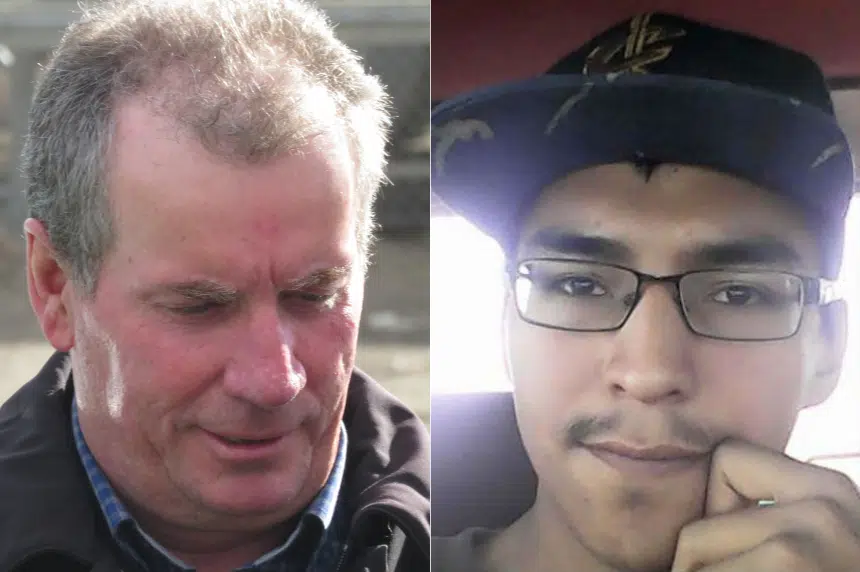Guns and bullet casings were the focus of an RCMP investigator’s testimony Tuesday at the second-degree murder trial of Gerald Stanley in Battleford, Sask.
Cpl. Terry Heroux, who examined the scene the night Colten Boushie was shot on Stanley’s farm, took the stand and presented a series of photos taken at the time.
Focus was placed on bullet casings with the markings “BXN 53,” two of which were found leading up to a crashed SUV on the property.
A third was found resting on the heating vent of the dashboard in the SUV, close to where blood matching Boushie’s stained the driver’s side.
A bag of matching ammunition was found in a drawer in Stanley’s shed.
Cpl. Heroux said 17 corroded shells with the same markings were also found near the steps of the Stanley home, indicating past use.
The Crown also noted through Heroux that 11 firearms were recovered in the home – two handguns in a closet, a shotgun and rifle in a bedroom, along with five rifles and two pellet guns in the basement.
Stanley had a license in his name for the handguns, the police officer added.
However, another firearm was the focus of defence lawyer Scott Spencer in his cross-examination.
The barrel of a .22 calibre rifle was found near Boushie’s body, with a round in the chamber and five more in a built-in magazine.
The barrel was bent, the bolt action damaged but in place and the stock was missing.
A stock was later found on a property “related” to the incident, but Cpl. Heroux said there was no way to match it to the barrel.
He also documented an empty box of .22 ammo in the SUV, with several live rounds and spent casings on the floor of the vehicle.
Cpl. Heroux said he didn’t know exactly where the rifle had come from.
A blood stain analyst who testified after said Boushie’s DNA was found on the rifle, either from direct spatter from the bullet impact or from dripping blood after.
Spencer also asked about the trajectory of the fatal bullet, which forensics showed entered behind Boushie’s left ear and exited his neck on the right side.
Heroux said because they didn’t know how Boushie’s head was positioned, and because of a hoody he was wearing that collected blood spatter, they couldn’t determine where the bullet went and couldn’t find it.
The testimony came after opening remarks from Crown Prosecutor Bill Burge, which previewed what witnesses may say to the jury and described a different chain of events than previously reported.
SUV CHAIN OF CUSTODY QUESTIONED
Another focus of the defence was how police handled the Ford Escape Boushie had been in when he died.
The SUV was removed from Stanley’s farm two days after the shooting, and placed in an RCMP secure bay for further examination.
After Cpl. Heroux had searched for fingerprints, documented evidence and swabbed the blood for analysis, the vehicle was towed away.
Spencer took exception to the process, noting his defence team didn’t have an opportunity to examine the vehicle.
“Don’t you think the defence should have had a chance to find the bullet? To examine the blood spatter?” he asked.
He suggested the release of the vehicle was contrary to policy, which Spencer said was to “hold biological evidence indefinitely.”
Cpl. Heroux maintained the release of the vehicle was consistent with RCMP practices, similar to how a house or trailer would be released as a crime scene.
FAMILY REACTS TO CRIME SCENE PHOTOS SHOWN IN COURT
A photo of Boushie’s body was also shown in court, drawing tears from family members in the room.
He was laying facedown, blood on his head, just outside the open driver’s door of the SUV. His clothes were disheveled, and his back slightly bare.
“It was difficult to see my nephew like that,” said Boushie’s uncle Alvin Baptiste.
Speaking outside the courthouse, he said Boushie’s mother, Debbie Baptiste, left the courtroom before the photo was shown.
“She’s having a very hard time,” Alvin said.
The second-degree murder trial continues Wednesday with more crown witnesses, starting with another police witness. Stanley’s son is also expected to testify.
—With files from 980 CJME’s Kevin Martel.











